Healthcare Report: Supporting Independent Living - Analysis
VerifiedAdded on 2021/02/21
|12
|4252
|37
Report
AI Summary
This report provides a comprehensive analysis of how technology supports independent living for individuals with disabilities. It begins by explaining the use of technology, such as digital gadgets and internet access, to assist individuals like Sally in managing their health and daily activities. The report then explores the barriers to technology adoption, including affordability, complexity, and reliance on batteries. It highlights the benefits of assistive technologies for both healthcare organizations and users, such as increased availability of devices, support in the recovery process, and the ability to lead a more normal life. Furthermore, the report delves into health and safety considerations, including the potential for hindering recovery, long-term health impacts, and device safety. Ethical considerations, such as privacy concerns and the potential for social isolation, are also examined. The report concludes by discussing the impact of technological developments on health and social care services, organizations, and care workers, offering recommendations for assistive devices and evaluating the overall usefulness of technology in enhancing the lives of those in need of care.

SUPPORTING
INDEPENDENT LIVING
INDEPENDENT LIVING
Paraphrase This Document
Need a fresh take? Get an instant paraphrase of this document with our AI Paraphraser
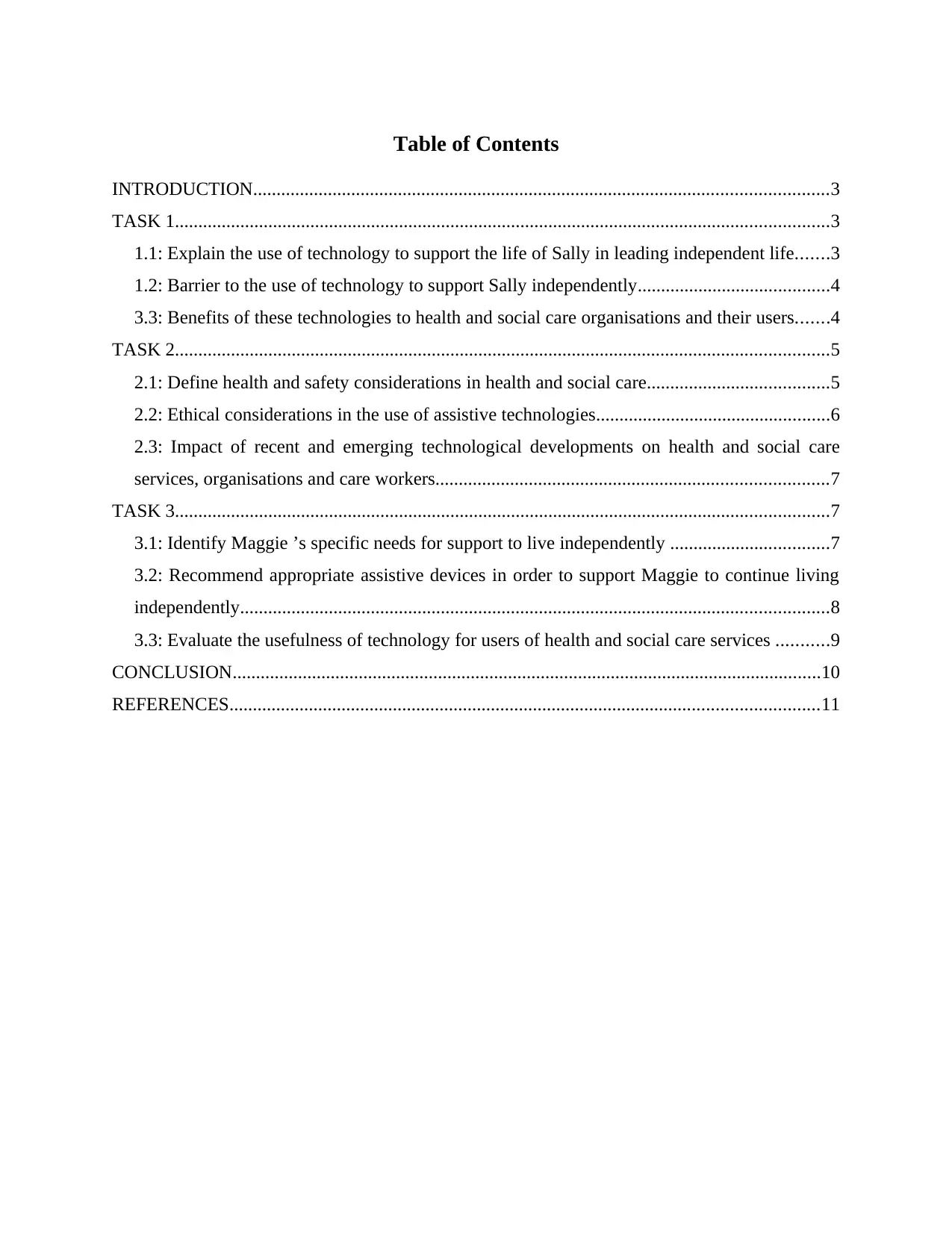
Table of Contents
INTRODUCTION...........................................................................................................................3
TASK 1............................................................................................................................................3
1.1: Explain the use of technology to support the life of Sally in leading independent life.......3
1.2: Barrier to the use of technology to support Sally independently.........................................4
3.3: Benefits of these technologies to health and social care organisations and their users.......4
TASK 2............................................................................................................................................5
2.1: Define health and safety considerations in health and social care.......................................5
2.2: Ethical considerations in the use of assistive technologies..................................................6
2.3: Impact of recent and emerging technological developments on health and social care
services, organisations and care workers....................................................................................7
TASK 3............................................................................................................................................7
3.1: Identify Maggie ’s specific needs for support to live independently ..................................7
3.2: Recommend appropriate assistive devices in order to support Maggie to continue living
independently..............................................................................................................................8
3.3: Evaluate the usefulness of technology for users of health and social care services ...........9
CONCLUSION..............................................................................................................................10
REFERENCES..............................................................................................................................11
INTRODUCTION...........................................................................................................................3
TASK 1............................................................................................................................................3
1.1: Explain the use of technology to support the life of Sally in leading independent life.......3
1.2: Barrier to the use of technology to support Sally independently.........................................4
3.3: Benefits of these technologies to health and social care organisations and their users.......4
TASK 2............................................................................................................................................5
2.1: Define health and safety considerations in health and social care.......................................5
2.2: Ethical considerations in the use of assistive technologies..................................................6
2.3: Impact of recent and emerging technological developments on health and social care
services, organisations and care workers....................................................................................7
TASK 3............................................................................................................................................7
3.1: Identify Maggie ’s specific needs for support to live independently ..................................7
3.2: Recommend appropriate assistive devices in order to support Maggie to continue living
independently..............................................................................................................................8
3.3: Evaluate the usefulness of technology for users of health and social care services ...........9
CONCLUSION..............................................................................................................................10
REFERENCES..............................................................................................................................11
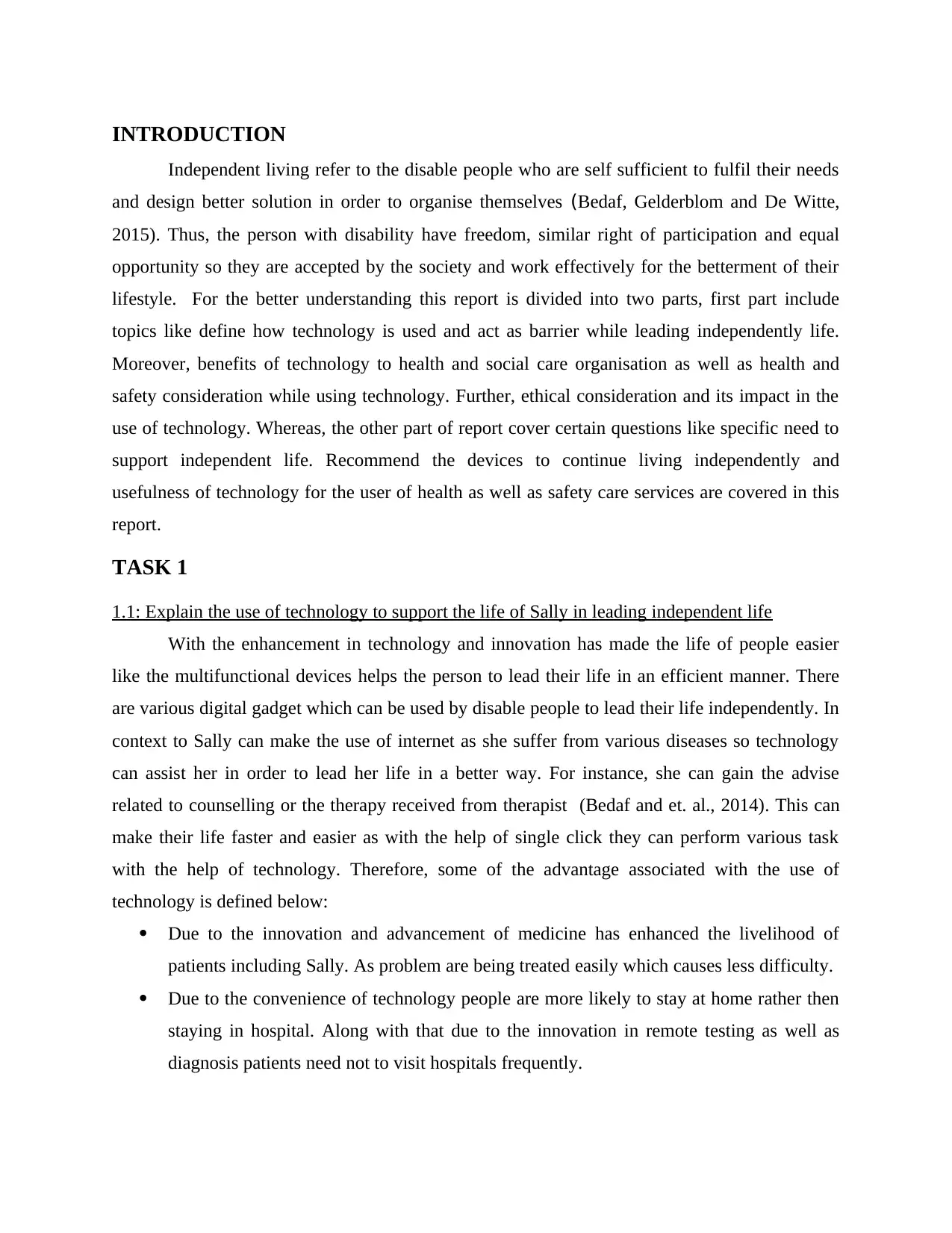
INTRODUCTION
Independent living refer to the disable people who are self sufficient to fulfil their needs
and design better solution in order to organise themselves (Bedaf, Gelderblom and De Witte,
2015). Thus, the person with disability have freedom, similar right of participation and equal
opportunity so they are accepted by the society and work effectively for the betterment of their
lifestyle. For the better understanding this report is divided into two parts, first part include
topics like define how technology is used and act as barrier while leading independently life.
Moreover, benefits of technology to health and social care organisation as well as health and
safety consideration while using technology. Further, ethical consideration and its impact in the
use of technology. Whereas, the other part of report cover certain questions like specific need to
support independent life. Recommend the devices to continue living independently and
usefulness of technology for the user of health as well as safety care services are covered in this
report.
TASK 1
1.1: Explain the use of technology to support the life of Sally in leading independent life
With the enhancement in technology and innovation has made the life of people easier
like the multifunctional devices helps the person to lead their life in an efficient manner. There
are various digital gadget which can be used by disable people to lead their life independently. In
context to Sally can make the use of internet as she suffer from various diseases so technology
can assist her in order to lead her life in a better way. For instance, she can gain the advise
related to counselling or the therapy received from therapist (Bedaf and et. al., 2014). This can
make their life faster and easier as with the help of single click they can perform various task
with the help of technology. Therefore, some of the advantage associated with the use of
technology is defined below:
Due to the innovation and advancement of medicine has enhanced the livelihood of
patients including Sally. As problem are being treated easily which causes less difficulty.
Due to the convenience of technology people are more likely to stay at home rather then
staying in hospital. Along with that due to the innovation in remote testing as well as
diagnosis patients need not to visit hospitals frequently.
Independent living refer to the disable people who are self sufficient to fulfil their needs
and design better solution in order to organise themselves (Bedaf, Gelderblom and De Witte,
2015). Thus, the person with disability have freedom, similar right of participation and equal
opportunity so they are accepted by the society and work effectively for the betterment of their
lifestyle. For the better understanding this report is divided into two parts, first part include
topics like define how technology is used and act as barrier while leading independently life.
Moreover, benefits of technology to health and social care organisation as well as health and
safety consideration while using technology. Further, ethical consideration and its impact in the
use of technology. Whereas, the other part of report cover certain questions like specific need to
support independent life. Recommend the devices to continue living independently and
usefulness of technology for the user of health as well as safety care services are covered in this
report.
TASK 1
1.1: Explain the use of technology to support the life of Sally in leading independent life
With the enhancement in technology and innovation has made the life of people easier
like the multifunctional devices helps the person to lead their life in an efficient manner. There
are various digital gadget which can be used by disable people to lead their life independently. In
context to Sally can make the use of internet as she suffer from various diseases so technology
can assist her in order to lead her life in a better way. For instance, she can gain the advise
related to counselling or the therapy received from therapist (Bedaf and et. al., 2014). This can
make their life faster and easier as with the help of single click they can perform various task
with the help of technology. Therefore, some of the advantage associated with the use of
technology is defined below:
Due to the innovation and advancement of medicine has enhanced the livelihood of
patients including Sally. As problem are being treated easily which causes less difficulty.
Due to the convenience of technology people are more likely to stay at home rather then
staying in hospital. Along with that due to the innovation in remote testing as well as
diagnosis patients need not to visit hospitals frequently.
⊘ This is a preview!⊘
Do you want full access?
Subscribe today to unlock all pages.

Trusted by 1+ million students worldwide
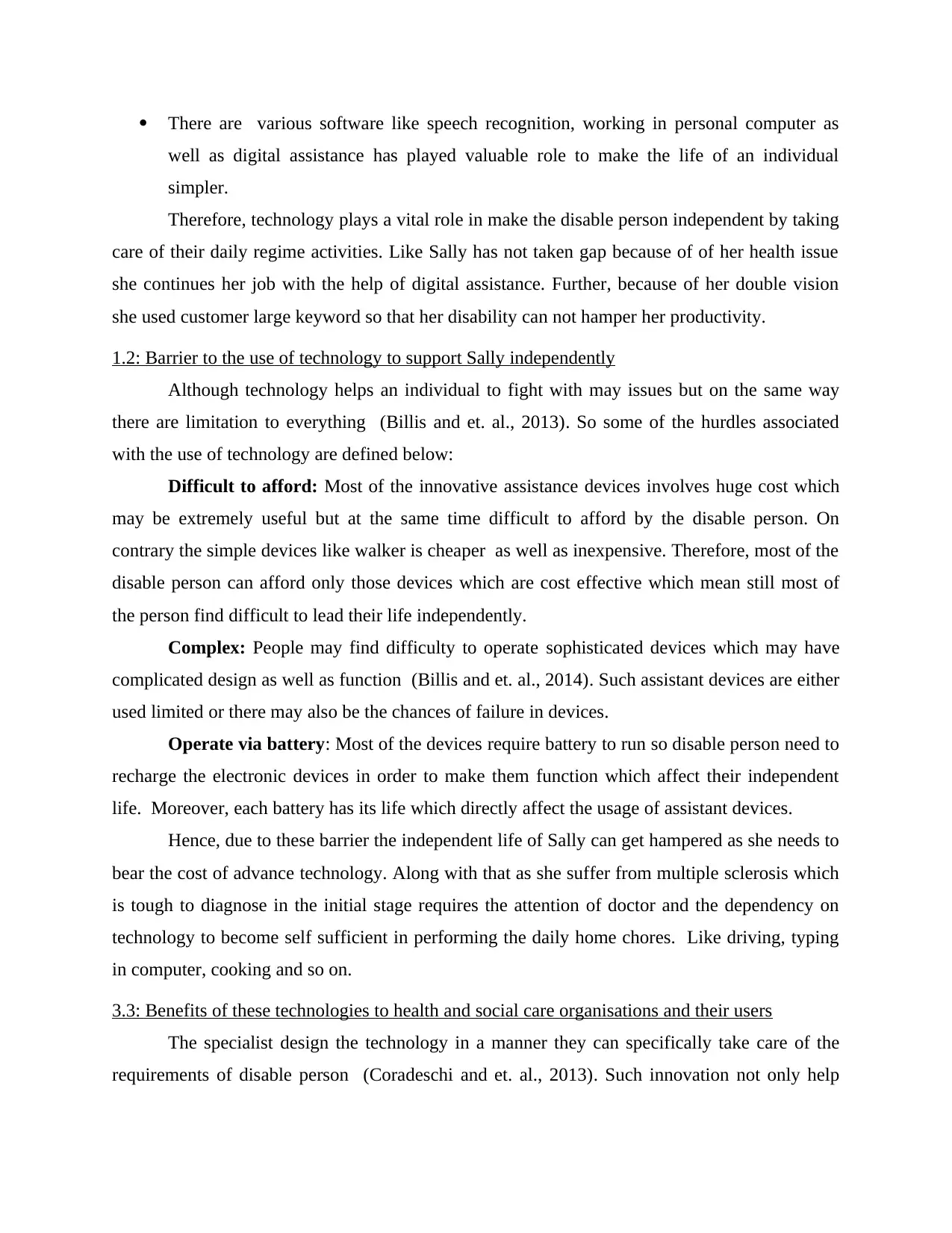
There are various software like speech recognition, working in personal computer as
well as digital assistance has played valuable role to make the life of an individual
simpler.
Therefore, technology plays a vital role in make the disable person independent by taking
care of their daily regime activities. Like Sally has not taken gap because of of her health issue
she continues her job with the help of digital assistance. Further, because of her double vision
she used customer large keyword so that her disability can not hamper her productivity.
1.2: Barrier to the use of technology to support Sally independently
Although technology helps an individual to fight with may issues but on the same way
there are limitation to everything (Billis and et. al., 2013). So some of the hurdles associated
with the use of technology are defined below:
Difficult to afford: Most of the innovative assistance devices involves huge cost which
may be extremely useful but at the same time difficult to afford by the disable person. On
contrary the simple devices like walker is cheaper as well as inexpensive. Therefore, most of the
disable person can afford only those devices which are cost effective which mean still most of
the person find difficult to lead their life independently.
Complex: People may find difficulty to operate sophisticated devices which may have
complicated design as well as function (Billis and et. al., 2014). Such assistant devices are either
used limited or there may also be the chances of failure in devices.
Operate via battery: Most of the devices require battery to run so disable person need to
recharge the electronic devices in order to make them function which affect their independent
life. Moreover, each battery has its life which directly affect the usage of assistant devices.
Hence, due to these barrier the independent life of Sally can get hampered as she needs to
bear the cost of advance technology. Along with that as she suffer from multiple sclerosis which
is tough to diagnose in the initial stage requires the attention of doctor and the dependency on
technology to become self sufficient in performing the daily home chores. Like driving, typing
in computer, cooking and so on.
3.3: Benefits of these technologies to health and social care organisations and their users
The specialist design the technology in a manner they can specifically take care of the
requirements of disable person (Coradeschi and et. al., 2013). Such innovation not only help
well as digital assistance has played valuable role to make the life of an individual
simpler.
Therefore, technology plays a vital role in make the disable person independent by taking
care of their daily regime activities. Like Sally has not taken gap because of of her health issue
she continues her job with the help of digital assistance. Further, because of her double vision
she used customer large keyword so that her disability can not hamper her productivity.
1.2: Barrier to the use of technology to support Sally independently
Although technology helps an individual to fight with may issues but on the same way
there are limitation to everything (Billis and et. al., 2013). So some of the hurdles associated
with the use of technology are defined below:
Difficult to afford: Most of the innovative assistance devices involves huge cost which
may be extremely useful but at the same time difficult to afford by the disable person. On
contrary the simple devices like walker is cheaper as well as inexpensive. Therefore, most of the
disable person can afford only those devices which are cost effective which mean still most of
the person find difficult to lead their life independently.
Complex: People may find difficulty to operate sophisticated devices which may have
complicated design as well as function (Billis and et. al., 2014). Such assistant devices are either
used limited or there may also be the chances of failure in devices.
Operate via battery: Most of the devices require battery to run so disable person need to
recharge the electronic devices in order to make them function which affect their independent
life. Moreover, each battery has its life which directly affect the usage of assistant devices.
Hence, due to these barrier the independent life of Sally can get hampered as she needs to
bear the cost of advance technology. Along with that as she suffer from multiple sclerosis which
is tough to diagnose in the initial stage requires the attention of doctor and the dependency on
technology to become self sufficient in performing the daily home chores. Like driving, typing
in computer, cooking and so on.
3.3: Benefits of these technologies to health and social care organisations and their users
The specialist design the technology in a manner they can specifically take care of the
requirements of disable person (Coradeschi and et. al., 2013). Such innovation not only help
Paraphrase This Document
Need a fresh take? Get an instant paraphrase of this document with our AI Paraphraser
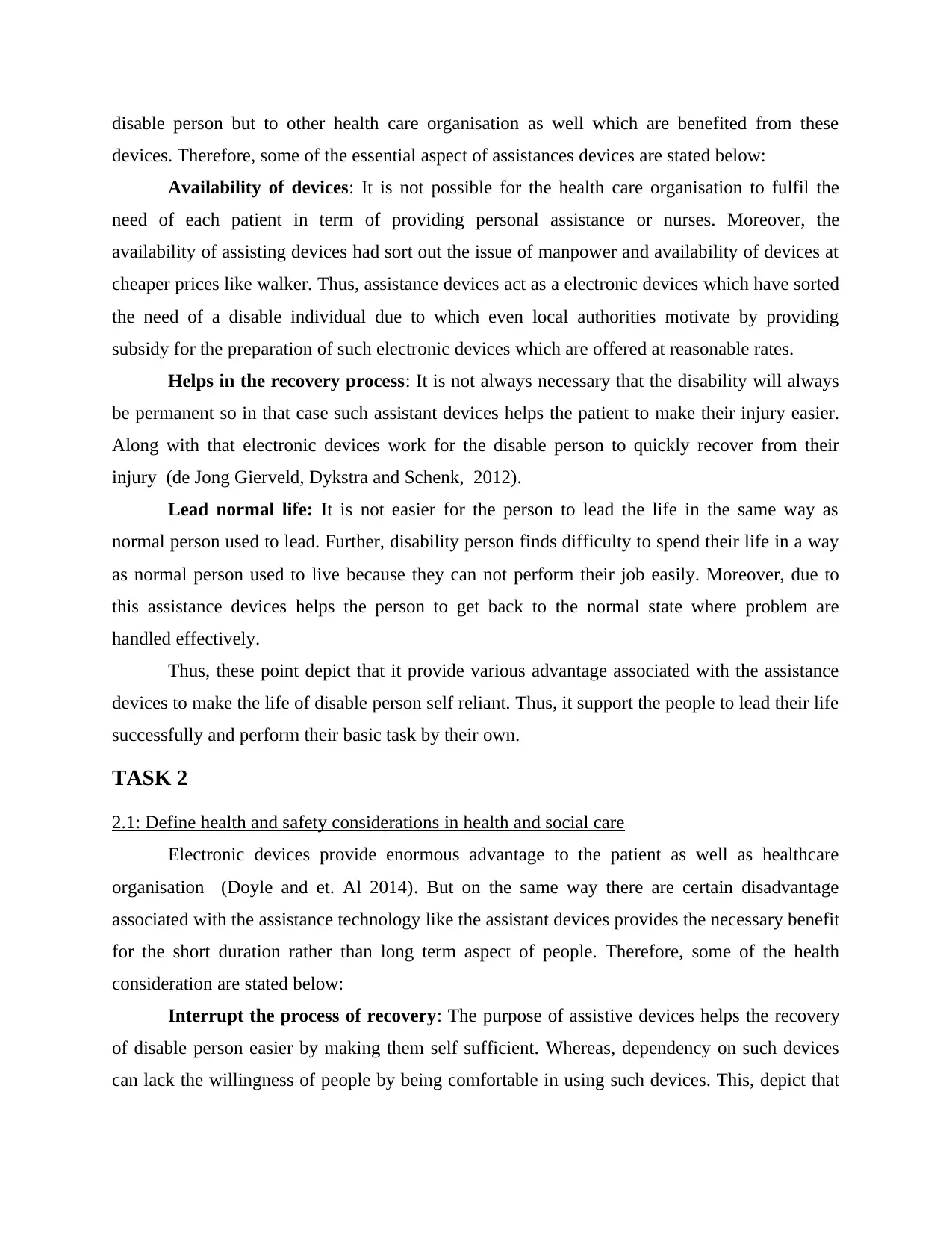
disable person but to other health care organisation as well which are benefited from these
devices. Therefore, some of the essential aspect of assistances devices are stated below:
Availability of devices: It is not possible for the health care organisation to fulfil the
need of each patient in term of providing personal assistance or nurses. Moreover, the
availability of assisting devices had sort out the issue of manpower and availability of devices at
cheaper prices like walker. Thus, assistance devices act as a electronic devices which have sorted
the need of a disable individual due to which even local authorities motivate by providing
subsidy for the preparation of such electronic devices which are offered at reasonable rates.
Helps in the recovery process: It is not always necessary that the disability will always
be permanent so in that case such assistant devices helps the patient to make their injury easier.
Along with that electronic devices work for the disable person to quickly recover from their
injury (de Jong Gierveld, Dykstra and Schenk, 2012).
Lead normal life: It is not easier for the person to lead the life in the same way as
normal person used to lead. Further, disability person finds difficulty to spend their life in a way
as normal person used to live because they can not perform their job easily. Moreover, due to
this assistance devices helps the person to get back to the normal state where problem are
handled effectively.
Thus, these point depict that it provide various advantage associated with the assistance
devices to make the life of disable person self reliant. Thus, it support the people to lead their life
successfully and perform their basic task by their own.
TASK 2
2.1: Define health and safety considerations in health and social care
Electronic devices provide enormous advantage to the patient as well as healthcare
organisation (Doyle and et. Al 2014). But on the same way there are certain disadvantage
associated with the assistance technology like the assistant devices provides the necessary benefit
for the short duration rather than long term aspect of people. Therefore, some of the health
consideration are stated below:
Interrupt the process of recovery: The purpose of assistive devices helps the recovery
of disable person easier by making them self sufficient. Whereas, dependency on such devices
can lack the willingness of people by being comfortable in using such devices. This, depict that
devices. Therefore, some of the essential aspect of assistances devices are stated below:
Availability of devices: It is not possible for the health care organisation to fulfil the
need of each patient in term of providing personal assistance or nurses. Moreover, the
availability of assisting devices had sort out the issue of manpower and availability of devices at
cheaper prices like walker. Thus, assistance devices act as a electronic devices which have sorted
the need of a disable individual due to which even local authorities motivate by providing
subsidy for the preparation of such electronic devices which are offered at reasonable rates.
Helps in the recovery process: It is not always necessary that the disability will always
be permanent so in that case such assistant devices helps the patient to make their injury easier.
Along with that electronic devices work for the disable person to quickly recover from their
injury (de Jong Gierveld, Dykstra and Schenk, 2012).
Lead normal life: It is not easier for the person to lead the life in the same way as
normal person used to lead. Further, disability person finds difficulty to spend their life in a way
as normal person used to live because they can not perform their job easily. Moreover, due to
this assistance devices helps the person to get back to the normal state where problem are
handled effectively.
Thus, these point depict that it provide various advantage associated with the assistance
devices to make the life of disable person self reliant. Thus, it support the people to lead their life
successfully and perform their basic task by their own.
TASK 2
2.1: Define health and safety considerations in health and social care
Electronic devices provide enormous advantage to the patient as well as healthcare
organisation (Doyle and et. Al 2014). But on the same way there are certain disadvantage
associated with the assistance technology like the assistant devices provides the necessary benefit
for the short duration rather than long term aspect of people. Therefore, some of the health
consideration are stated below:
Interrupt the process of recovery: The purpose of assistive devices helps the recovery
of disable person easier by making them self sufficient. Whereas, dependency on such devices
can lack the willingness of people by being comfortable in using such devices. This, depict that
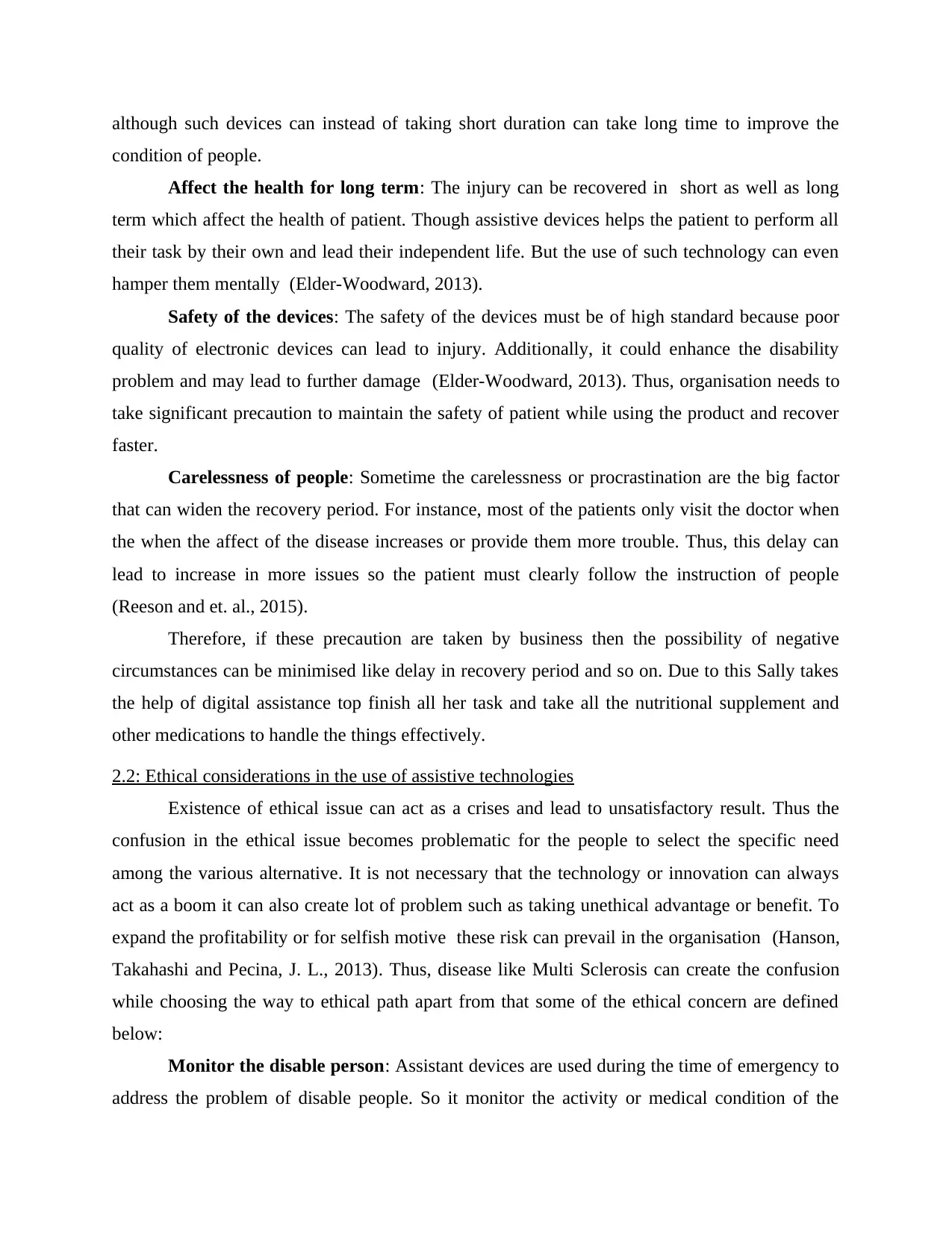
although such devices can instead of taking short duration can take long time to improve the
condition of people.
Affect the health for long term: The injury can be recovered in short as well as long
term which affect the health of patient. Though assistive devices helps the patient to perform all
their task by their own and lead their independent life. But the use of such technology can even
hamper them mentally (Elder-Woodward, 2013).
Safety of the devices: The safety of the devices must be of high standard because poor
quality of electronic devices can lead to injury. Additionally, it could enhance the disability
problem and may lead to further damage (Elder-Woodward, 2013). Thus, organisation needs to
take significant precaution to maintain the safety of patient while using the product and recover
faster.
Carelessness of people: Sometime the carelessness or procrastination are the big factor
that can widen the recovery period. For instance, most of the patients only visit the doctor when
the when the affect of the disease increases or provide them more trouble. Thus, this delay can
lead to increase in more issues so the patient must clearly follow the instruction of people
(Reeson and et. al., 2015).
Therefore, if these precaution are taken by business then the possibility of negative
circumstances can be minimised like delay in recovery period and so on. Due to this Sally takes
the help of digital assistance top finish all her task and take all the nutritional supplement and
other medications to handle the things effectively.
2.2: Ethical considerations in the use of assistive technologies
Existence of ethical issue can act as a crises and lead to unsatisfactory result. Thus the
confusion in the ethical issue becomes problematic for the people to select the specific need
among the various alternative. It is not necessary that the technology or innovation can always
act as a boom it can also create lot of problem such as taking unethical advantage or benefit. To
expand the profitability or for selfish motive these risk can prevail in the organisation (Hanson,
Takahashi and Pecina, J. L., 2013). Thus, disease like Multi Sclerosis can create the confusion
while choosing the way to ethical path apart from that some of the ethical concern are defined
below:
Monitor the disable person: Assistant devices are used during the time of emergency to
address the problem of disable people. So it monitor the activity or medical condition of the
condition of people.
Affect the health for long term: The injury can be recovered in short as well as long
term which affect the health of patient. Though assistive devices helps the patient to perform all
their task by their own and lead their independent life. But the use of such technology can even
hamper them mentally (Elder-Woodward, 2013).
Safety of the devices: The safety of the devices must be of high standard because poor
quality of electronic devices can lead to injury. Additionally, it could enhance the disability
problem and may lead to further damage (Elder-Woodward, 2013). Thus, organisation needs to
take significant precaution to maintain the safety of patient while using the product and recover
faster.
Carelessness of people: Sometime the carelessness or procrastination are the big factor
that can widen the recovery period. For instance, most of the patients only visit the doctor when
the when the affect of the disease increases or provide them more trouble. Thus, this delay can
lead to increase in more issues so the patient must clearly follow the instruction of people
(Reeson and et. al., 2015).
Therefore, if these precaution are taken by business then the possibility of negative
circumstances can be minimised like delay in recovery period and so on. Due to this Sally takes
the help of digital assistance top finish all her task and take all the nutritional supplement and
other medications to handle the things effectively.
2.2: Ethical considerations in the use of assistive technologies
Existence of ethical issue can act as a crises and lead to unsatisfactory result. Thus the
confusion in the ethical issue becomes problematic for the people to select the specific need
among the various alternative. It is not necessary that the technology or innovation can always
act as a boom it can also create lot of problem such as taking unethical advantage or benefit. To
expand the profitability or for selfish motive these risk can prevail in the organisation (Hanson,
Takahashi and Pecina, J. L., 2013). Thus, disease like Multi Sclerosis can create the confusion
while choosing the way to ethical path apart from that some of the ethical concern are defined
below:
Monitor the disable person: Assistant devices are used during the time of emergency to
address the problem of disable people. So it monitor the activity or medical condition of the
⊘ This is a preview!⊘
Do you want full access?
Subscribe today to unlock all pages.

Trusted by 1+ million students worldwide
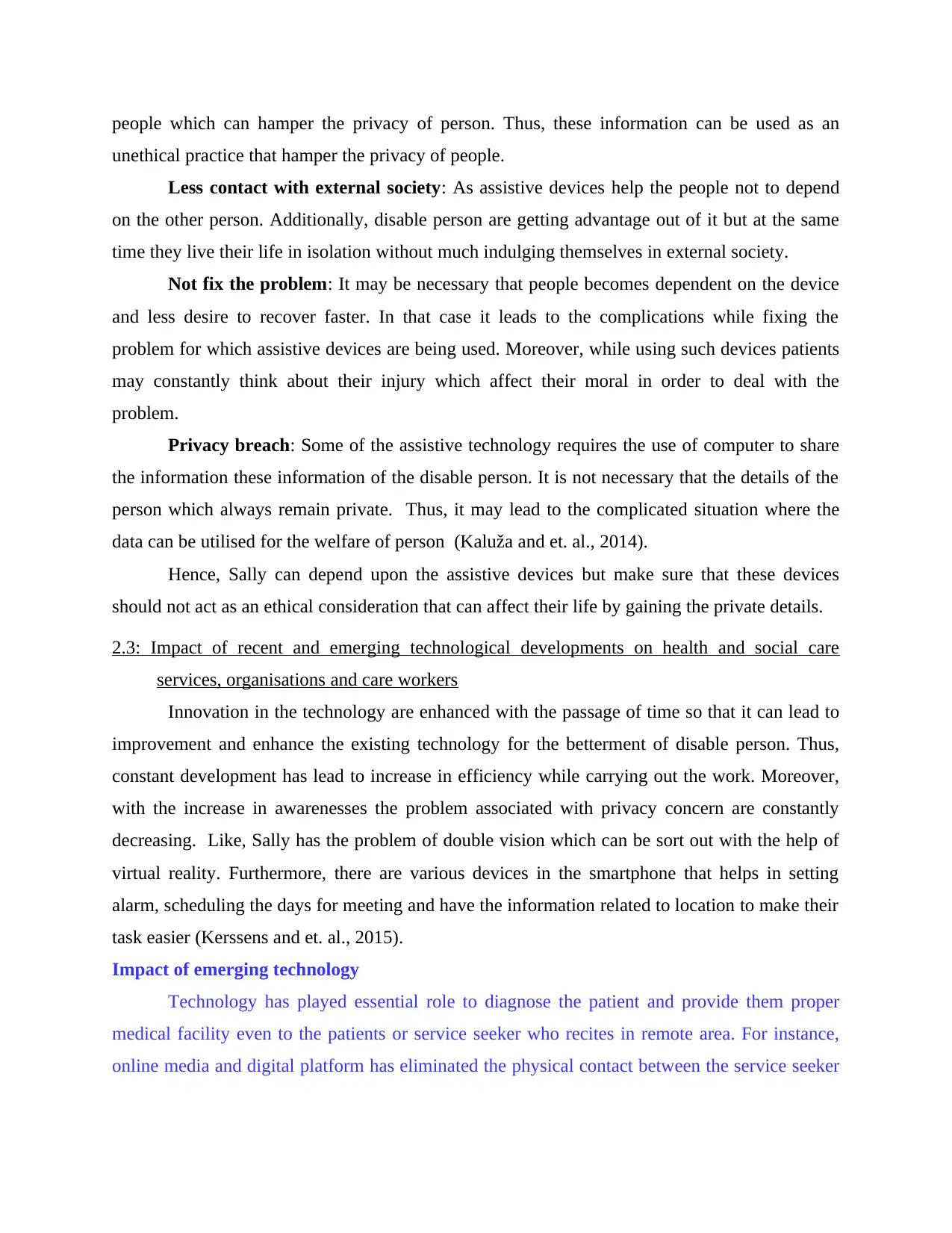
people which can hamper the privacy of person. Thus, these information can be used as an
unethical practice that hamper the privacy of people.
Less contact with external society: As assistive devices help the people not to depend
on the other person. Additionally, disable person are getting advantage out of it but at the same
time they live their life in isolation without much indulging themselves in external society.
Not fix the problem: It may be necessary that people becomes dependent on the device
and less desire to recover faster. In that case it leads to the complications while fixing the
problem for which assistive devices are being used. Moreover, while using such devices patients
may constantly think about their injury which affect their moral in order to deal with the
problem.
Privacy breach: Some of the assistive technology requires the use of computer to share
the information these information of the disable person. It is not necessary that the details of the
person which always remain private. Thus, it may lead to the complicated situation where the
data can be utilised for the welfare of person (Kaluža and et. al., 2014).
Hence, Sally can depend upon the assistive devices but make sure that these devices
should not act as an ethical consideration that can affect their life by gaining the private details.
2.3: Impact of recent and emerging technological developments on health and social care
services, organisations and care workers
Innovation in the technology are enhanced with the passage of time so that it can lead to
improvement and enhance the existing technology for the betterment of disable person. Thus,
constant development has lead to increase in efficiency while carrying out the work. Moreover,
with the increase in awarenesses the problem associated with privacy concern are constantly
decreasing. Like, Sally has the problem of double vision which can be sort out with the help of
virtual reality. Furthermore, there are various devices in the smartphone that helps in setting
alarm, scheduling the days for meeting and have the information related to location to make their
task easier (Kerssens and et. al., 2015).
Impact of emerging technology
Technology has played essential role to diagnose the patient and provide them proper
medical facility even to the patients or service seeker who recites in remote area. For instance,
online media and digital platform has eliminated the physical contact between the service seeker
unethical practice that hamper the privacy of people.
Less contact with external society: As assistive devices help the people not to depend
on the other person. Additionally, disable person are getting advantage out of it but at the same
time they live their life in isolation without much indulging themselves in external society.
Not fix the problem: It may be necessary that people becomes dependent on the device
and less desire to recover faster. In that case it leads to the complications while fixing the
problem for which assistive devices are being used. Moreover, while using such devices patients
may constantly think about their injury which affect their moral in order to deal with the
problem.
Privacy breach: Some of the assistive technology requires the use of computer to share
the information these information of the disable person. It is not necessary that the details of the
person which always remain private. Thus, it may lead to the complicated situation where the
data can be utilised for the welfare of person (Kaluža and et. al., 2014).
Hence, Sally can depend upon the assistive devices but make sure that these devices
should not act as an ethical consideration that can affect their life by gaining the private details.
2.3: Impact of recent and emerging technological developments on health and social care
services, organisations and care workers
Innovation in the technology are enhanced with the passage of time so that it can lead to
improvement and enhance the existing technology for the betterment of disable person. Thus,
constant development has lead to increase in efficiency while carrying out the work. Moreover,
with the increase in awarenesses the problem associated with privacy concern are constantly
decreasing. Like, Sally has the problem of double vision which can be sort out with the help of
virtual reality. Furthermore, there are various devices in the smartphone that helps in setting
alarm, scheduling the days for meeting and have the information related to location to make their
task easier (Kerssens and et. al., 2015).
Impact of emerging technology
Technology has played essential role to diagnose the patient and provide them proper
medical facility even to the patients or service seeker who recites in remote area. For instance,
online media and digital platform has eliminated the physical contact between the service seeker
Paraphrase This Document
Need a fresh take? Get an instant paraphrase of this document with our AI Paraphraser
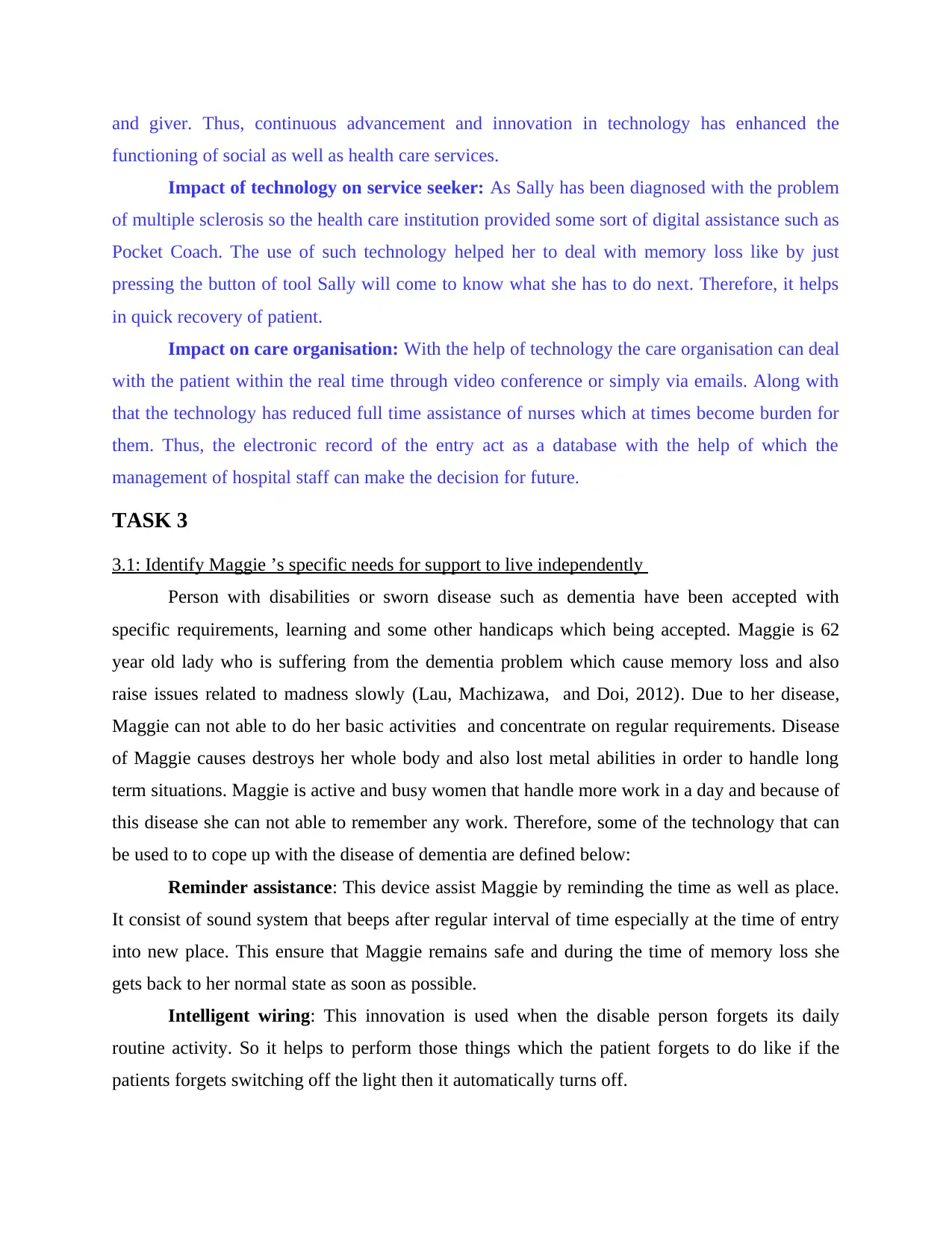
and giver. Thus, continuous advancement and innovation in technology has enhanced the
functioning of social as well as health care services.
Impact of technology on service seeker: As Sally has been diagnosed with the problem
of multiple sclerosis so the health care institution provided some sort of digital assistance such as
Pocket Coach. The use of such technology helped her to deal with memory loss like by just
pressing the button of tool Sally will come to know what she has to do next. Therefore, it helps
in quick recovery of patient.
Impact on care organisation: With the help of technology the care organisation can deal
with the patient within the real time through video conference or simply via emails. Along with
that the technology has reduced full time assistance of nurses which at times become burden for
them. Thus, the electronic record of the entry act as a database with the help of which the
management of hospital staff can make the decision for future.
TASK 3
3.1: Identify Maggie ’s specific needs for support to live independently
Person with disabilities or sworn disease such as dementia have been accepted with
specific requirements, learning and some other handicaps which being accepted. Maggie is 62
year old lady who is suffering from the dementia problem which cause memory loss and also
raise issues related to madness slowly (Lau, Machizawa, and Doi, 2012). Due to her disease,
Maggie can not able to do her basic activities and concentrate on regular requirements. Disease
of Maggie causes destroys her whole body and also lost metal abilities in order to handle long
term situations. Maggie is active and busy women that handle more work in a day and because of
this disease she can not able to remember any work. Therefore, some of the technology that can
be used to to cope up with the disease of dementia are defined below:
Reminder assistance: This device assist Maggie by reminding the time as well as place.
It consist of sound system that beeps after regular interval of time especially at the time of entry
into new place. This ensure that Maggie remains safe and during the time of memory loss she
gets back to her normal state as soon as possible.
Intelligent wiring: This innovation is used when the disable person forgets its daily
routine activity. So it helps to perform those things which the patient forgets to do like if the
patients forgets switching off the light then it automatically turns off.
functioning of social as well as health care services.
Impact of technology on service seeker: As Sally has been diagnosed with the problem
of multiple sclerosis so the health care institution provided some sort of digital assistance such as
Pocket Coach. The use of such technology helped her to deal with memory loss like by just
pressing the button of tool Sally will come to know what she has to do next. Therefore, it helps
in quick recovery of patient.
Impact on care organisation: With the help of technology the care organisation can deal
with the patient within the real time through video conference or simply via emails. Along with
that the technology has reduced full time assistance of nurses which at times become burden for
them. Thus, the electronic record of the entry act as a database with the help of which the
management of hospital staff can make the decision for future.
TASK 3
3.1: Identify Maggie ’s specific needs for support to live independently
Person with disabilities or sworn disease such as dementia have been accepted with
specific requirements, learning and some other handicaps which being accepted. Maggie is 62
year old lady who is suffering from the dementia problem which cause memory loss and also
raise issues related to madness slowly (Lau, Machizawa, and Doi, 2012). Due to her disease,
Maggie can not able to do her basic activities and concentrate on regular requirements. Disease
of Maggie causes destroys her whole body and also lost metal abilities in order to handle long
term situations. Maggie is active and busy women that handle more work in a day and because of
this disease she can not able to remember any work. Therefore, some of the technology that can
be used to to cope up with the disease of dementia are defined below:
Reminder assistance: This device assist Maggie by reminding the time as well as place.
It consist of sound system that beeps after regular interval of time especially at the time of entry
into new place. This ensure that Maggie remains safe and during the time of memory loss she
gets back to her normal state as soon as possible.
Intelligent wiring: This innovation is used when the disable person forgets its daily
routine activity. So it helps to perform those things which the patient forgets to do like if the
patients forgets switching off the light then it automatically turns off.
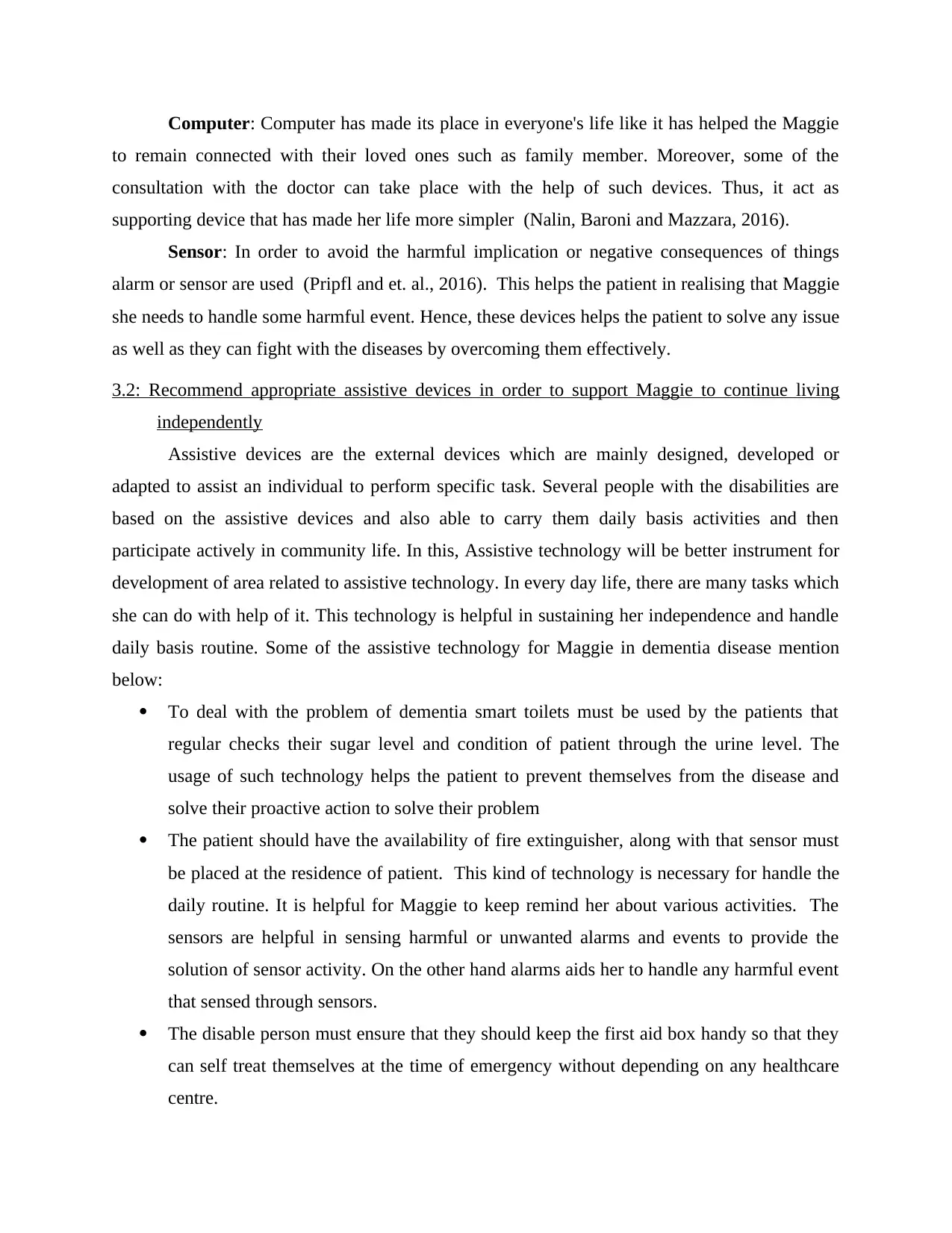
Computer: Computer has made its place in everyone's life like it has helped the Maggie
to remain connected with their loved ones such as family member. Moreover, some of the
consultation with the doctor can take place with the help of such devices. Thus, it act as
supporting device that has made her life more simpler (Nalin, Baroni and Mazzara, 2016).
Sensor: In order to avoid the harmful implication or negative consequences of things
alarm or sensor are used (Pripfl and et. al., 2016). This helps the patient in realising that Maggie
she needs to handle some harmful event. Hence, these devices helps the patient to solve any issue
as well as they can fight with the diseases by overcoming them effectively.
3.2: Recommend appropriate assistive devices in order to support Maggie to continue living
independently
Assistive devices are the external devices which are mainly designed, developed or
adapted to assist an individual to perform specific task. Several people with the disabilities are
based on the assistive devices and also able to carry them daily basis activities and then
participate actively in community life. In this, Assistive technology will be better instrument for
development of area related to assistive technology. In every day life, there are many tasks which
she can do with help of it. This technology is helpful in sustaining her independence and handle
daily basis routine. Some of the assistive technology for Maggie in dementia disease mention
below:
To deal with the problem of dementia smart toilets must be used by the patients that
regular checks their sugar level and condition of patient through the urine level. The
usage of such technology helps the patient to prevent themselves from the disease and
solve their proactive action to solve their problem
The patient should have the availability of fire extinguisher, along with that sensor must
be placed at the residence of patient. This kind of technology is necessary for handle the
daily routine. It is helpful for Maggie to keep remind her about various activities. The
sensors are helpful in sensing harmful or unwanted alarms and events to provide the
solution of sensor activity. On the other hand alarms aids her to handle any harmful event
that sensed through sensors.
The disable person must ensure that they should keep the first aid box handy so that they
can self treat themselves at the time of emergency without depending on any healthcare
centre.
to remain connected with their loved ones such as family member. Moreover, some of the
consultation with the doctor can take place with the help of such devices. Thus, it act as
supporting device that has made her life more simpler (Nalin, Baroni and Mazzara, 2016).
Sensor: In order to avoid the harmful implication or negative consequences of things
alarm or sensor are used (Pripfl and et. al., 2016). This helps the patient in realising that Maggie
she needs to handle some harmful event. Hence, these devices helps the patient to solve any issue
as well as they can fight with the diseases by overcoming them effectively.
3.2: Recommend appropriate assistive devices in order to support Maggie to continue living
independently
Assistive devices are the external devices which are mainly designed, developed or
adapted to assist an individual to perform specific task. Several people with the disabilities are
based on the assistive devices and also able to carry them daily basis activities and then
participate actively in community life. In this, Assistive technology will be better instrument for
development of area related to assistive technology. In every day life, there are many tasks which
she can do with help of it. This technology is helpful in sustaining her independence and handle
daily basis routine. Some of the assistive technology for Maggie in dementia disease mention
below:
To deal with the problem of dementia smart toilets must be used by the patients that
regular checks their sugar level and condition of patient through the urine level. The
usage of such technology helps the patient to prevent themselves from the disease and
solve their proactive action to solve their problem
The patient should have the availability of fire extinguisher, along with that sensor must
be placed at the residence of patient. This kind of technology is necessary for handle the
daily routine. It is helpful for Maggie to keep remind her about various activities. The
sensors are helpful in sensing harmful or unwanted alarms and events to provide the
solution of sensor activity. On the other hand alarms aids her to handle any harmful event
that sensed through sensors.
The disable person must ensure that they should keep the first aid box handy so that they
can self treat themselves at the time of emergency without depending on any healthcare
centre.
⊘ This is a preview!⊘
Do you want full access?
Subscribe today to unlock all pages.

Trusted by 1+ million students worldwide
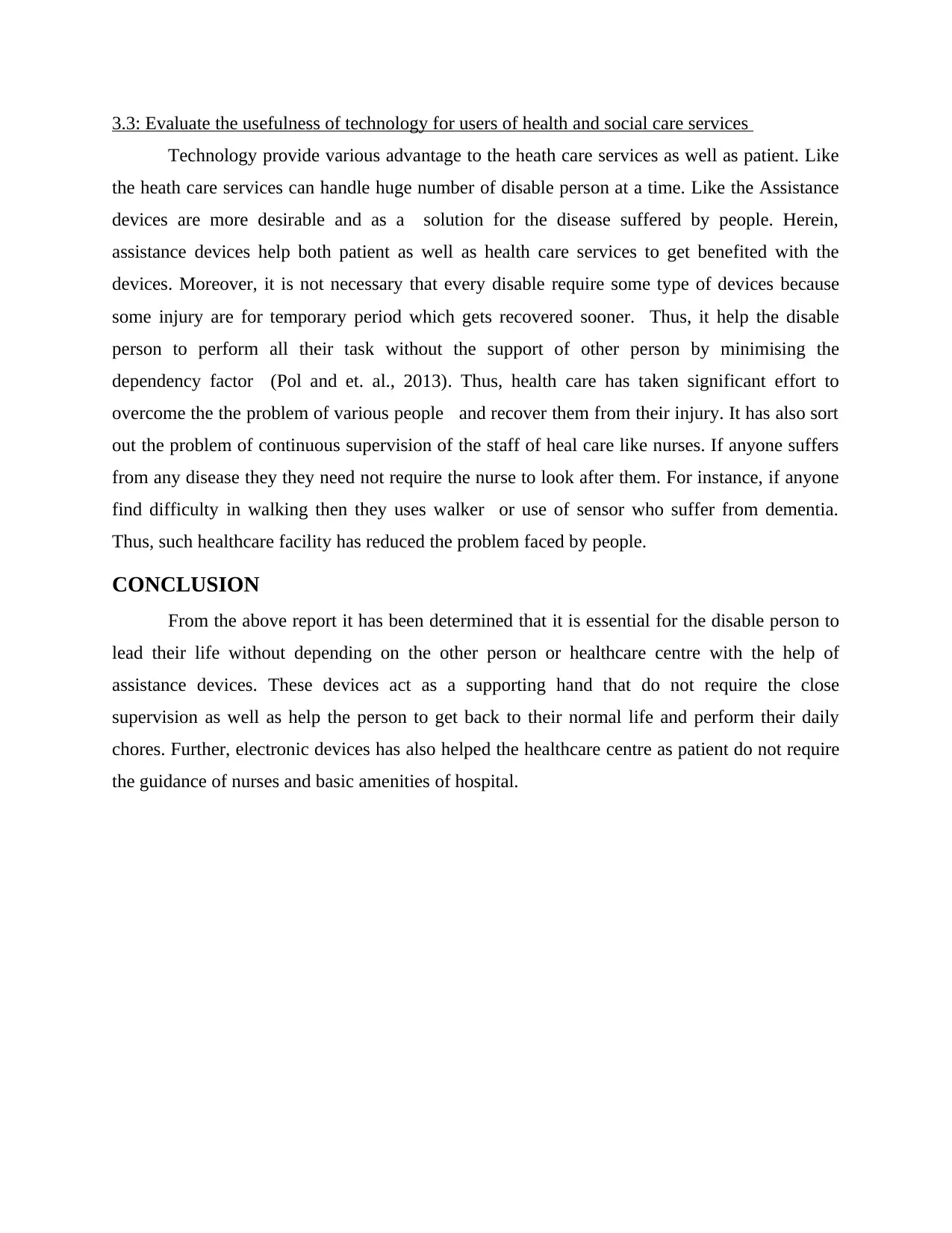
3.3: Evaluate the usefulness of technology for users of health and social care services
Technology provide various advantage to the heath care services as well as patient. Like
the heath care services can handle huge number of disable person at a time. Like the Assistance
devices are more desirable and as a solution for the disease suffered by people. Herein,
assistance devices help both patient as well as health care services to get benefited with the
devices. Moreover, it is not necessary that every disable require some type of devices because
some injury are for temporary period which gets recovered sooner. Thus, it help the disable
person to perform all their task without the support of other person by minimising the
dependency factor (Pol and et. al., 2013). Thus, health care has taken significant effort to
overcome the the problem of various people and recover them from their injury. It has also sort
out the problem of continuous supervision of the staff of heal care like nurses. If anyone suffers
from any disease they they need not require the nurse to look after them. For instance, if anyone
find difficulty in walking then they uses walker or use of sensor who suffer from dementia.
Thus, such healthcare facility has reduced the problem faced by people.
CONCLUSION
From the above report it has been determined that it is essential for the disable person to
lead their life without depending on the other person or healthcare centre with the help of
assistance devices. These devices act as a supporting hand that do not require the close
supervision as well as help the person to get back to their normal life and perform their daily
chores. Further, electronic devices has also helped the healthcare centre as patient do not require
the guidance of nurses and basic amenities of hospital.
Technology provide various advantage to the heath care services as well as patient. Like
the heath care services can handle huge number of disable person at a time. Like the Assistance
devices are more desirable and as a solution for the disease suffered by people. Herein,
assistance devices help both patient as well as health care services to get benefited with the
devices. Moreover, it is not necessary that every disable require some type of devices because
some injury are for temporary period which gets recovered sooner. Thus, it help the disable
person to perform all their task without the support of other person by minimising the
dependency factor (Pol and et. al., 2013). Thus, health care has taken significant effort to
overcome the the problem of various people and recover them from their injury. It has also sort
out the problem of continuous supervision of the staff of heal care like nurses. If anyone suffers
from any disease they they need not require the nurse to look after them. For instance, if anyone
find difficulty in walking then they uses walker or use of sensor who suffer from dementia.
Thus, such healthcare facility has reduced the problem faced by people.
CONCLUSION
From the above report it has been determined that it is essential for the disable person to
lead their life without depending on the other person or healthcare centre with the help of
assistance devices. These devices act as a supporting hand that do not require the close
supervision as well as help the person to get back to their normal life and perform their daily
chores. Further, electronic devices has also helped the healthcare centre as patient do not require
the guidance of nurses and basic amenities of hospital.
Paraphrase This Document
Need a fresh take? Get an instant paraphrase of this document with our AI Paraphraser
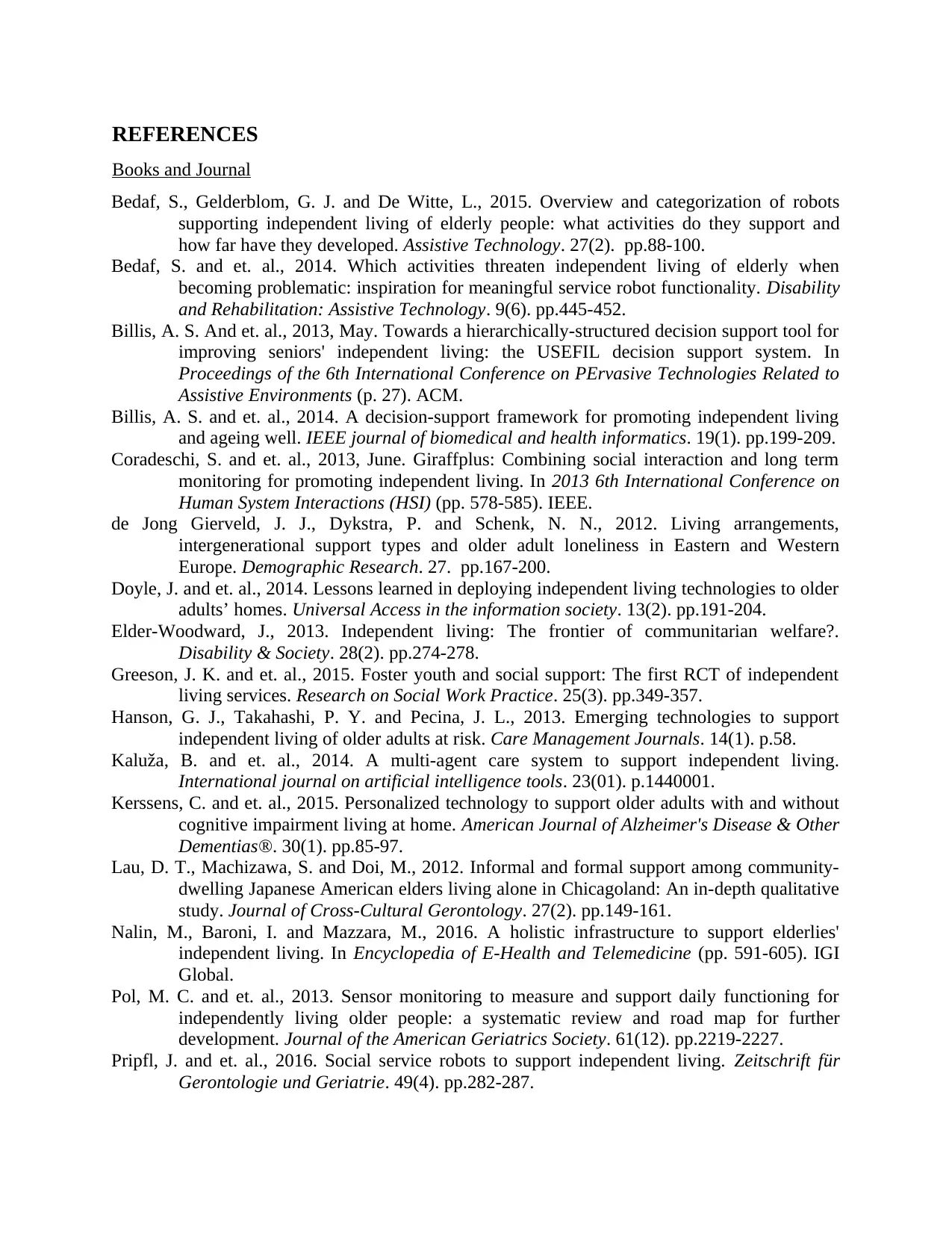
REFERENCES
Books and Journal
Bedaf, S., Gelderblom, G. J. and De Witte, L., 2015. Overview and categorization of robots
supporting independent living of elderly people: what activities do they support and
how far have they developed. Assistive Technology. 27(2). pp.88-100.
Bedaf, S. and et. al., 2014. Which activities threaten independent living of elderly when
becoming problematic: inspiration for meaningful service robot functionality. Disability
and Rehabilitation: Assistive Technology. 9(6). pp.445-452.
Billis, A. S. And et. al., 2013, May. Towards a hierarchically-structured decision support tool for
improving seniors' independent living: the USEFIL decision support system. In
Proceedings of the 6th International Conference on PErvasive Technologies Related to
Assistive Environments (p. 27). ACM.
Billis, A. S. and et. al., 2014. A decision-support framework for promoting independent living
and ageing well. IEEE journal of biomedical and health informatics. 19(1). pp.199-209.
Coradeschi, S. and et. al., 2013, June. Giraffplus: Combining social interaction and long term
monitoring for promoting independent living. In 2013 6th International Conference on
Human System Interactions (HSI) (pp. 578-585). IEEE.
de Jong Gierveld, J. J., Dykstra, P. and Schenk, N. N., 2012. Living arrangements,
intergenerational support types and older adult loneliness in Eastern and Western
Europe. Demographic Research. 27. pp.167-200.
Doyle, J. and et. al., 2014. Lessons learned in deploying independent living technologies to older
adults’ homes. Universal Access in the information society. 13(2). pp.191-204.
Elder-Woodward, J., 2013. Independent living: The frontier of communitarian welfare?.
Disability & Society. 28(2). pp.274-278.
Greeson, J. K. and et. al., 2015. Foster youth and social support: The first RCT of independent
living services. Research on Social Work Practice. 25(3). pp.349-357.
Hanson, G. J., Takahashi, P. Y. and Pecina, J. L., 2013. Emerging technologies to support
independent living of older adults at risk. Care Management Journals. 14(1). p.58.
Kaluža, B. and et. al., 2014. A multi-agent care system to support independent living.
International journal on artificial intelligence tools. 23(01). p.1440001.
Kerssens, C. and et. al., 2015. Personalized technology to support older adults with and without
cognitive impairment living at home. American Journal of Alzheimer's Disease & Other
Dementias®. 30(1). pp.85-97.
Lau, D. T., Machizawa, S. and Doi, M., 2012. Informal and formal support among community-
dwelling Japanese American elders living alone in Chicagoland: An in-depth qualitative
study. Journal of Cross-Cultural Gerontology. 27(2). pp.149-161.
Nalin, M., Baroni, I. and Mazzara, M., 2016. A holistic infrastructure to support elderlies'
independent living. In Encyclopedia of E-Health and Telemedicine (pp. 591-605). IGI
Global.
Pol, M. C. and et. al., 2013. Sensor monitoring to measure and support daily functioning for
independently living older people: a systematic review and road map for further
development. Journal of the American Geriatrics Society. 61(12). pp.2219-2227.
Pripfl, J. and et. al., 2016. Social service robots to support independent living. Zeitschrift für
Gerontologie und Geriatrie. 49(4). pp.282-287.
Books and Journal
Bedaf, S., Gelderblom, G. J. and De Witte, L., 2015. Overview and categorization of robots
supporting independent living of elderly people: what activities do they support and
how far have they developed. Assistive Technology. 27(2). pp.88-100.
Bedaf, S. and et. al., 2014. Which activities threaten independent living of elderly when
becoming problematic: inspiration for meaningful service robot functionality. Disability
and Rehabilitation: Assistive Technology. 9(6). pp.445-452.
Billis, A. S. And et. al., 2013, May. Towards a hierarchically-structured decision support tool for
improving seniors' independent living: the USEFIL decision support system. In
Proceedings of the 6th International Conference on PErvasive Technologies Related to
Assistive Environments (p. 27). ACM.
Billis, A. S. and et. al., 2014. A decision-support framework for promoting independent living
and ageing well. IEEE journal of biomedical and health informatics. 19(1). pp.199-209.
Coradeschi, S. and et. al., 2013, June. Giraffplus: Combining social interaction and long term
monitoring for promoting independent living. In 2013 6th International Conference on
Human System Interactions (HSI) (pp. 578-585). IEEE.
de Jong Gierveld, J. J., Dykstra, P. and Schenk, N. N., 2012. Living arrangements,
intergenerational support types and older adult loneliness in Eastern and Western
Europe. Demographic Research. 27. pp.167-200.
Doyle, J. and et. al., 2014. Lessons learned in deploying independent living technologies to older
adults’ homes. Universal Access in the information society. 13(2). pp.191-204.
Elder-Woodward, J., 2013. Independent living: The frontier of communitarian welfare?.
Disability & Society. 28(2). pp.274-278.
Greeson, J. K. and et. al., 2015. Foster youth and social support: The first RCT of independent
living services. Research on Social Work Practice. 25(3). pp.349-357.
Hanson, G. J., Takahashi, P. Y. and Pecina, J. L., 2013. Emerging technologies to support
independent living of older adults at risk. Care Management Journals. 14(1). p.58.
Kaluža, B. and et. al., 2014. A multi-agent care system to support independent living.
International journal on artificial intelligence tools. 23(01). p.1440001.
Kerssens, C. and et. al., 2015. Personalized technology to support older adults with and without
cognitive impairment living at home. American Journal of Alzheimer's Disease & Other
Dementias®. 30(1). pp.85-97.
Lau, D. T., Machizawa, S. and Doi, M., 2012. Informal and formal support among community-
dwelling Japanese American elders living alone in Chicagoland: An in-depth qualitative
study. Journal of Cross-Cultural Gerontology. 27(2). pp.149-161.
Nalin, M., Baroni, I. and Mazzara, M., 2016. A holistic infrastructure to support elderlies'
independent living. In Encyclopedia of E-Health and Telemedicine (pp. 591-605). IGI
Global.
Pol, M. C. and et. al., 2013. Sensor monitoring to measure and support daily functioning for
independently living older people: a systematic review and road map for further
development. Journal of the American Geriatrics Society. 61(12). pp.2219-2227.
Pripfl, J. and et. al., 2016. Social service robots to support independent living. Zeitschrift für
Gerontologie und Geriatrie. 49(4). pp.282-287.

⊘ This is a preview!⊘
Do you want full access?
Subscribe today to unlock all pages.

Trusted by 1+ million students worldwide
1 out of 12
Related Documents
Your All-in-One AI-Powered Toolkit for Academic Success.
+13062052269
info@desklib.com
Available 24*7 on WhatsApp / Email
![[object Object]](/_next/static/media/star-bottom.7253800d.svg)
Unlock your academic potential
Copyright © 2020–2025 A2Z Services. All Rights Reserved. Developed and managed by ZUCOL.





